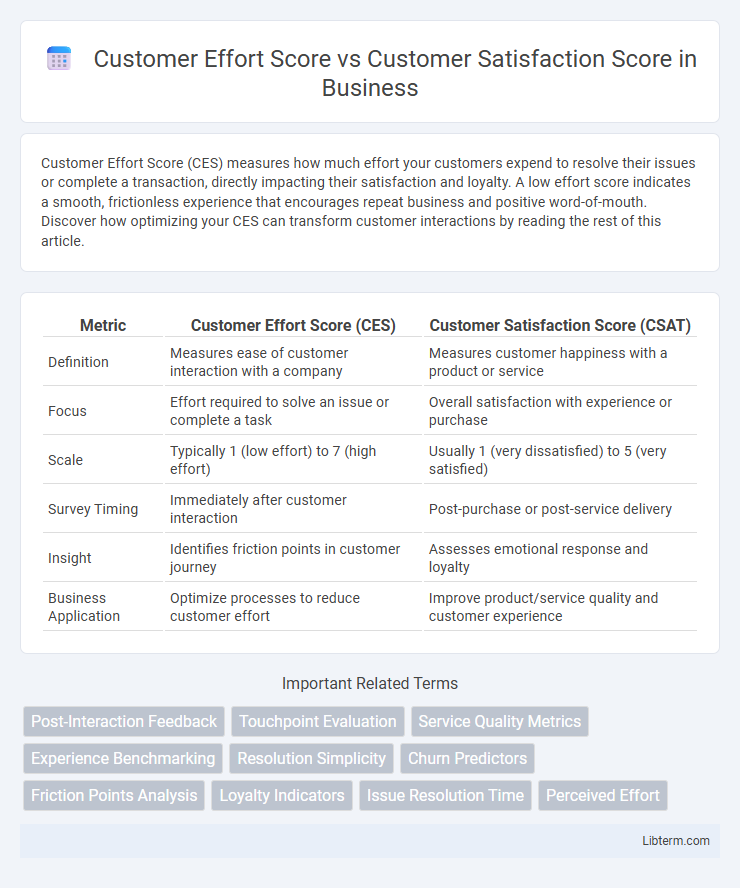Customer Effort Score (CES) measures how much effort your customers expend to resolve their issues or complete a transaction, directly impacting their satisfaction and loyalty. A low effort score indicates a smooth, frictionless experience that encourages repeat business and positive word-of-mouth. Discover how optimizing your CES can transform customer interactions by reading the rest of this article.
Table of Comparison
| Metric | Customer Effort Score (CES) | Customer Satisfaction Score (CSAT) |
|---|---|---|
| Definition | Measures ease of customer interaction with a company | Measures customer happiness with a product or service |
| Focus | Effort required to solve an issue or complete a task | Overall satisfaction with experience or purchase |
| Scale | Typically 1 (low effort) to 7 (high effort) | Usually 1 (very dissatisfied) to 5 (very satisfied) |
| Survey Timing | Immediately after customer interaction | Post-purchase or post-service delivery |
| Insight | Identifies friction points in customer journey | Assesses emotional response and loyalty |
| Business Application | Optimize processes to reduce customer effort | Improve product/service quality and customer experience |
Understanding Customer Effort Score (CES)
Customer Effort Score (CES) measures the ease with which customers can complete a specific interaction, reflecting the effort required to resolve issues or obtain services. This metric focuses on minimizing friction points in the customer journey, often correlating directly with customer loyalty and repeat business. CES provides actionable insights for businesses aiming to improve processes and reduce barriers, contrasting with Customer Satisfaction Score (CSAT), which captures overall satisfaction but not the specific effort involved.
What is Customer Satisfaction Score (CSAT)?
Customer Satisfaction Score (CSAT) measures how satisfied customers are with a product, service, or interaction, typically using a scale from 1 to 5 or 1 to 10. It directly reflects customers' immediate feelings and perceptions, providing actionable insights to improve experiences. CSAT is different from Customer Effort Score (CES), which gauges the ease of customer interactions rather than satisfaction levels.
Key Differences Between CES and CSAT
Customer Effort Score (CES) measures the ease of customer interactions, focusing on the effort required to resolve an issue, while Customer Satisfaction Score (CSAT) evaluates overall satisfaction with a product or service. CES typically uses a scale from "very easy" to "very difficult," emphasizing post-interaction friction, whereas CSAT uses numerical or Likert scales to capture satisfaction levels immediately following an experience. CES aims to predict customer loyalty by reducing effort, whereas CSAT assesses emotional reactions and general contentment.
How CES Measures Customer Experience
Customer Effort Score (CES) measures customer experience by quantifying the ease of a customer's interaction with a company or service, focusing on the specific effort required to resolve an issue or complete a task. Unlike Customer Satisfaction Score (CSAT), which captures overall satisfaction, CES directly evaluates friction points and streamlines service improvements by identifying barriers in the customer journey. High CES results indicate a low-effort experience, correlating strongly with increased customer loyalty and reduced churn rates.
How CSAT Evaluates Customer Feedback
Customer Satisfaction Score (CSAT) evaluates customer feedback by directly measuring the level of satisfaction with a specific interaction, product, or service, typically through survey questions rated on a scale from very dissatisfied to very satisfied. CSAT focuses on capturing immediate emotional responses and perceived value, providing actionable insights into customer experience quality at key touchpoints. Unlike Customer Effort Score (CES), which assesses the ease of resolution, CSAT gauges overall contentment, making it essential for understanding customer approval and loyalty drivers.
When to Use CES vs CSAT
Use Customer Effort Score (CES) to measure how easily customers complete specific interactions or resolve issues, making it ideal for post-support or transaction evaluations. Customer Satisfaction Score (CSAT) captures overall contentment with a product or service, best suited for gauging general satisfaction after product use or service delivery. CES is preferred when improving operational touchpoints, while CSAT guides broader customer experience enhancements.
Benefits of Tracking CES in Your Business
Tracking Customer Effort Score (CES) provides businesses with precise insights into how easily customers can interact with products or services, directly impacting retention and loyalty. Lowering customer effort enhances the overall experience by reducing frustration, leading to faster issue resolution and increased repeat purchases. Unlike Customer Satisfaction Score (CSAT), CES highlights process efficiency, enabling companies to optimize touchpoints and minimize barriers in the customer journey.
Advantages of Monitoring CSAT
Monitoring Customer Satisfaction Score (CSAT) provides direct insights into customer happiness with products or services, enabling businesses to pinpoint immediate areas for improvement. High CSAT scores correlate strongly with customer retention and positive word-of-mouth, boosting brand loyalty and revenue growth. Regularly tracking CSAT facilitates the identification of specific pain points, allowing targeted strategies that enhance overall customer experience.
Integrating CES and CSAT for Holistic Insights
Integrating Customer Effort Score (CES) and Customer Satisfaction Score (CSAT) provides a comprehensive understanding of the customer experience by measuring both the ease of interaction and overall satisfaction. Combining CES metrics, which assess the effort required for service resolution, with CSAT data, reflecting customers' emotional responses, allows businesses to pinpoint friction points and enhance service quality effectively. This dual approach enables targeted improvements that drive higher loyalty and reduce churn by addressing both functional and emotional aspects of customer relationships.
Choosing the Right Metric for Your Customer Journey
Customer Effort Score (CES) measures the ease of customer interactions, directly highlighting friction points in the customer journey, while Customer Satisfaction Score (CSAT) gauges overall happiness with a product or service. Selecting the right metric depends on the stage of the customer journey: CES is ideal for post-interaction evaluation to reduce effort barriers, whereas CSAT provides insight into broad satisfaction at key touchpoints. Analyzing CES alongside CSAT offers a comprehensive understanding of both effort and satisfaction, enabling targeted improvements that enhance customer experience and loyalty.
Customer Effort Score Infographic

 libterm.com
libterm.com